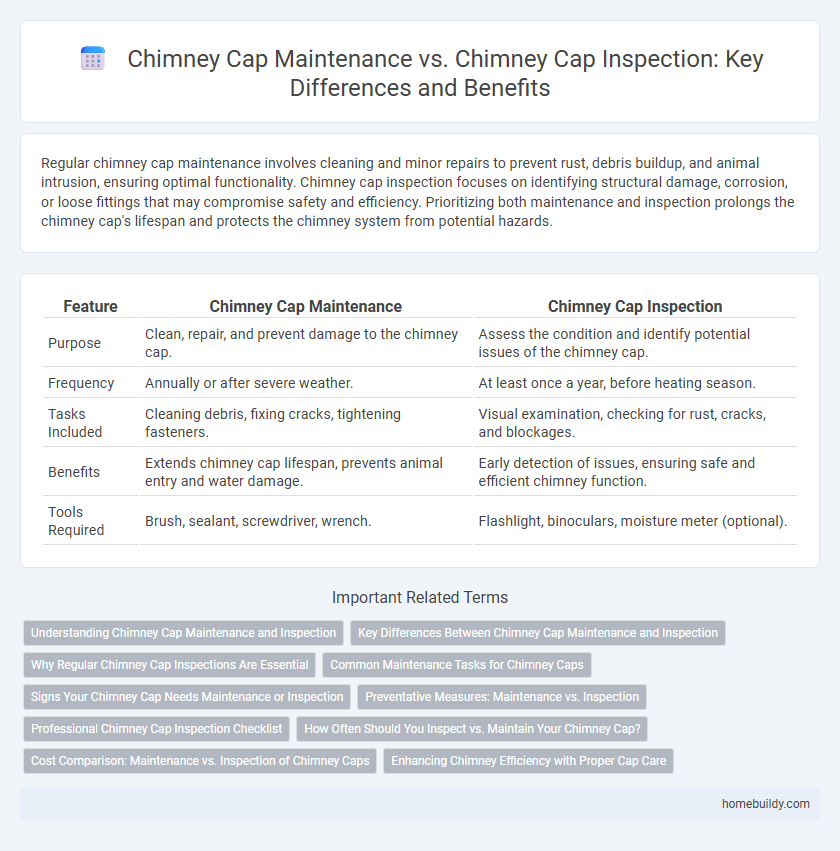Regular chimney cap maintenance involves cleaning and minor repairs to prevent rust, debris buildup, and animal intrusion, ensuring optimal functionality. Chimney cap inspection focuses on identifying structural damage, corrosion, or loose fittings that may compromise safety and efficiency. Prioritizing both maintenance and inspection prolongs the chimney cap's lifespan and protects the chimney system from potential hazards.
Table of Comparison
| Feature | Chimney Cap Maintenance | Chimney Cap Inspection |
|---|---|---|
| Purpose | Clean, repair, and prevent damage to the chimney cap. | Assess the condition and identify potential issues of the chimney cap. |
| Frequency | Annually or after severe weather. | At least once a year, before heating season. |
| Tasks Included | Cleaning debris, fixing cracks, tightening fasteners. | Visual examination, checking for rust, cracks, and blockages. |
| Benefits | Extends chimney cap lifespan, prevents animal entry and water damage. | Early detection of issues, ensuring safe and efficient chimney function. |
| Tools Required | Brush, sealant, screwdriver, wrench. | Flashlight, binoculars, moisture meter (optional). |
Understanding Chimney Cap Maintenance and Inspection
Chimney cap maintenance involves regular cleaning, rust prevention, and securing the cap to protect against water damage, debris, and animal entry. Chimney cap inspection focuses on detailed examination for cracks, corrosion, and structural integrity to ensure effective performance and safety. Both maintenance and inspection are essential for prolonging chimney lifespan and preventing costly repairs.
Key Differences Between Chimney Cap Maintenance and Inspection
Chimney cap maintenance involves regular cleaning and repairs to prevent rust, corrosion, and blockage, ensuring the cap's longevity and effectiveness in protecting the chimney from rain, debris, and animals. Chimney cap inspection focuses on assessing the structural integrity, checking for damage, proper fit, and signs of wear or deterioration that may compromise its function. Maintenance is proactive and routine, while inspection is diagnostic, identifying potential issues needing repair or replacement.
Why Regular Chimney Cap Inspections Are Essential
Regular chimney cap inspections are essential to identify corrosion, blockages, or damage that can compromise chimney function and safety. Inspections help detect early signs of wear, animal nests, or debris buildup before maintenance or repairs become costly. Routine checks ensure the chimney cap effectively protects against moisture, sparks, and pests, prolonging the lifespan of the entire chimney system.
Common Maintenance Tasks for Chimney Caps
Chimney cap maintenance primarily involves routine cleaning of debris, checking for rust or corrosion, and ensuring the mesh is free from blockages to prevent animal entry and water damage. Inspections focus on evaluating the structural integrity, verifying proper installation, and identifying any signs of wear that may require repairs or replacement. Regular maintenance extends the lifespan of chimney caps, while inspections help detect potential issues before they escalate into costly problems.
Signs Your Chimney Cap Needs Maintenance or Inspection
Signs your chimney cap needs maintenance include visible rust, cracks, or holes that compromise its ability to keep out debris and animals. Inspection is necessary when you notice soot buildup around the cap or experience unusual draft patterns, indicating potential blockages or damage. Regular chimney cap inspections help identify early signs of wear and prevent costly repairs by ensuring the cap remains structurally sound and functional.
Preventative Measures: Maintenance vs. Inspection
Chimney cap maintenance involves routine cleaning and repairs to prevent blockages, corrosion, and animal intrusion, ensuring long-term functionality. Chimney cap inspection focuses on identifying early signs of damage, rust, or structural issues before they escalate into expensive repairs. Regular inspections combined with proactive maintenance provide an effective preventative strategy to extend the lifespan and safety of the chimney cap.
Professional Chimney Cap Inspection Checklist
A professional chimney cap inspection checklist includes evaluating the cap's structural integrity, checking for rust, corrosion, or damage from weather exposure, and ensuring the screen is free of debris or blockages that can hinder ventilation. Regular chimney cap maintenance involves cleaning soot and creosote buildup, tightening loose fittings, and applying protective coatings to prolong the cap's lifespan. Inspections identify maintenance needs early, preventing costly repairs and ensuring optimal chimney operation and safety.
How Often Should You Inspect vs. Maintain Your Chimney Cap?
Chimney caps should be inspected at least once a year, ideally before the heating season begins, to identify any damage, rust, or blockages caused by debris or animals. Maintenance tasks such as cleaning and minor repairs are typically recommended every 2-3 years, depending on the local climate and exposure to harsh weather conditions. Regular inspections help determine whether immediate maintenance is needed, preventing costly damage and ensuring optimal chimney performance.
Cost Comparison: Maintenance vs. Inspection of Chimney Caps
Chimney cap maintenance involves cleaning, rust repair, and sealant application, typically costing $50 to $150 annually, while inspection services range from $75 to $200 per visit and focus on assessing structural integrity and preventing hazards. Regular maintenance can reduce long-term expenses by preventing deterioration, whereas inspections identify potential issues before costly repairs arise. Investing in routine maintenance alongside periodic inspections offers a cost-effective strategy to extend chimney cap lifespan and ensure safety.
Enhancing Chimney Efficiency with Proper Cap Care
Regular chimney cap maintenance ensures the prevention of rust, debris buildup, and animal nests, significantly prolonging the cap's lifespan and maintaining optimal airflow. Periodic chimney cap inspection identifies early signs of damage or blockages that can reduce chimney efficiency and increase the risk of smoke backdrafts. Implementing a balanced approach of thorough cleaning and timely inspections enhances overall chimney performance and safety, preserving indoor air quality and heating efficiency.
Chimney cap maintenance vs Chimney cap inspection Infographic

 homebuildy.com
homebuildy.com